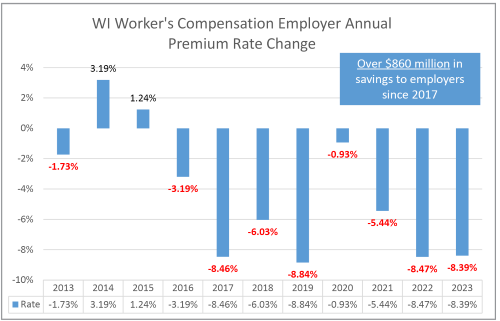Worker's Compensation
Wisconsin’s worker’s compensation program and our high-quality, high-value health care system sets us apart from the rest of the country—making Wisconsin an attractive place to do business. Learn more about WHA's advocacy related work on this webpage.
Government Price Setting is Wrong Public Policy
Wisconsin’s worker’s compensation program is a national model, with injured workers returning to their job a full three weeks faster than the national average. Medical providers play a key role in making these outcomes a reality, at costs well below the national average.
A recently released study from the Benefit Services Group (BSG) and HC Trends recognizes the worker’s compensation system for its quality, efficiency and production of excellent outcomes for workers and employers. The study uses data from the Worker’s Compensation Research Institute (WCRI), a national not-for-profit research organization that compares state worker’s compensation programs.
Wisconsin’s worker’s compensation premiums are declining. Despite a workplace injury rate 28 percent higher than the national average, Wisconsin’s worker’s compensation premium rates have declined 3.2 percent in 2016, 8.5 percent in 2017, saving Wisconsin businesses over $300 million in 2017 and 2018.
 According to WCRI, the overall medical costs per Worker’s Comp claim in Wisconsin are 18 percent lower than the national average.
According to WCRI, the overall medical costs per Worker’s Comp claim in Wisconsin are 18 percent lower than the national average.
Wisconsin provides more efficient health care. WCRI data indicates Wisconsin providers billed 26 percent fewer office visits and provided 13 percent fewer services per visit than the national average for worker’s compensation claims involving more than seven days of lost work time.
Wisconsin’s injured workers have better health outcomes, return to work more quickly and are more satisfied with their care than injured workers in other states, resulting in lower litigation and savings for employers. Wisconsin has the highest employee satisfaction rate among states with 82 percent of employees being either “somewhat” or “very satisfied” with their overall medical care.
While some want to equate worker’s compensation insurance to other payers of health care, like group health insurance, worker’s compensation operates much differently. Even though health care providers must navigate the “Worker’s Compensation Obstacle Course”, patients still get to work faster in Wisconsin than any other state in the nation. This, combined with costs that are in line with the national average, provides for great Wisconsin Value for employers and injured workers.
Wisconsin’s worker’s compensation program is laden with middlemen between the health care provider, patient and their worker’s compensation insurer/employer. This inefficiency and noise in the worker’s comp system is creating additional costs for employers and delays for injured workers.
All of this aside, Wisconsin’s hospitals and health systems are not only providing the best outcomes once a worker is injured – they are partnering with local manufacturers and other employers to reduce Wisconsin’s workplace injury rate and support employers looking to implement better safety and wellness programs.
WHA is strongly opposed to a government imposed medical fee schedule in worker’s compensation, similar to what is experienced in other government programs like Medicaid and Medicare. By cutting reimbursement for Wisconsin hospitals and health systems that serve injured workers, it removes resources to work on injury prevention and wellness programs for employers.
Focusing on fee schedules detracts from a discussion on meaningful reforms. Fee schedules can preempt discussions on changes that could lower costs by streamlining claims administration. This includes the sometimes archaic, costly and cumbersome administrative and operational processes prevalent among worker’s compensation carriers.

